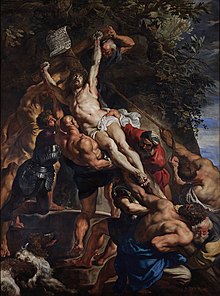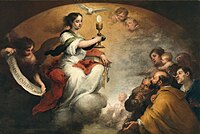
Back الرسم الفلمنكي الباروكي Arabic Pintura barroca a Flandes Catalan Φλαμανδική ζωγραφική μπαρόκ Greek Pintura barroca de Flandes Spanish نقاشی باروک فلاندری Persian Peinture baroque flamande French Vlaamse barokschilderkunst Dutch Barroco flamengo Portuguese Барок у Фландрији Serbian จิตรกรรมบารอกแบบเฟลมิช Thai

Flemish Baroque painting was a style of painting in the Southern Netherlands during Spanish control in the 16th and 17th centuries. The period roughly begins when the Dutch Republic was split from the Habsburg Spain regions to the south with the Spanish recapturing of Antwerp in 1585 and goes until about 1700, when Spanish Habsburg authority ended with the death of King Charles II.[1] Antwerp, home to the prominent artists Peter Paul Rubens, Anthony van Dyck, and Jacob Jordaens, was the artistic nexus, while other notable cities include Brussels and Ghent.[1]
Rubens, in particular, had a strong influence on seventeenth-century visual culture. His innovations helped define Antwerp as one of Europe's major artistic cities, especially for Counter-Reformation imagery, and his student Van Dyck was instrumental in establishing new directions in English portraiture. Other developments in Flemish Baroque painting are similar to those found in Dutch Golden Age painting,[1] with artists specializing in such areas as history painting, portraiture, genre painting, landscape painting, and still life.
| History of Dutch and Flemish painting |
|---|
| Periods |
|
| Lists |
| Part of a series on |
| Catholic Counter-Reformation |
|---|
 |
| Catholic Reformation and Revival |
© MMXXIII Rich X Search. We shall prevail. All rights reserved. Rich X Search